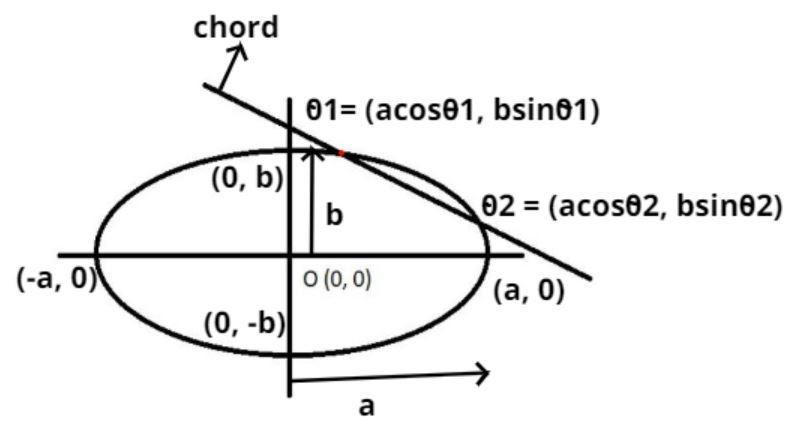Question
Question: The chord joining two points \({\theta _1}{\text{ and }}{\theta _2}\)on the ellipse \(\dfrac{{{x^2}}...
The chord joining two points θ1 and θ2on the ellipse a2x2+b2y2=1 such that tanθ1tanθ2=−b2a2 will subtend a right angle at
(a) focus (b) center (c) end of the major axis (d) end of the minor axis
Solution
Hint: In this question suppose two points θ1 and θ2 such that θ1=(acosθ1,bsinθ1) and θ2=(acosθ2,bsinθ2)through which the chord passes. Then use the concept of slope of line passing through two given points to find the slope of Oθ1 and Oθ2 where O is the origin. Use the concept that if two lines are perpendicular then their slopes are related as m1×m2=−1.
Complete step-by-step answer:

The chord joining two points (θ1,θ2) on the ellipse a2x2+b2y2=1 is shown above.
As we know that the ellipse is having a center (O) = (0, 0) is also shown in the figure.
Let us suppose the point θ1=(acosθ1,bsinθ1) and θ2=(acosθ2,bsinθ2) is also shown in the figure.
Now as we know that the slope between two points (x1,y1) and (x2,y2) is given as
Slope (m) = x2−x1y2−y1
So find out the slopes of (Oθ1) and (Oθ2).
Let O = (x1,y1) = (0, 0)
θ1=(x2,y2)=(acosθ1,bsinθ1)
θ2=(x3,y3)=(acosθ2,bsinθ2)
So let the slope of (0θ1) be m1.
⇒m1=x2−x1y2−y1=acosθ1−0bsinθ1−0=abtanθ1
Now let the slope of (Oθ2) be m2.
⇒m1=x3−x1y3−y1=acosθ2−0bsinθ2−0=abtanθ2
Now multiply the slopes we have
⇒m1×m2=abtanθ1×abtanθ2=a2b2tanθ1tanθ2........................ (1)
Now it is given that
tanθ1tanθ2=−b2a2
Now substitute this value in equation (1) we have,
⇒m1×m2=a2b2tanθ1tanθ2=a2b2×b2−a2=−1
So multiplication of slopes is (-1) which is the condition of the right angle.
Therefore the chord joining two points (θ1,θ2) on the ellipse a2x2+b2y2=1 will subtend a right angle at origin or center.
Hence option (B) is correct.
Note: The center of the given ellipse that is a2x2+b2y2=1 is (0, 0) that is the origin that’s why option (c) is correct. The equation of shifted ellipse or the ellipse whose center is not at origin is given by a2(x−p)2+b2(y−q)2=1 here the center is at (p, q).
